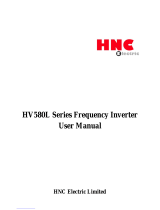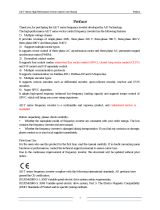27
SY80 00
6
4
3
1
4
3
0.2 2u f、5 0v
SY8000
28
3. 5 . 3 Instruction for the conne c t i on of control terminal
1)Analog input terminal:
The faint analog voltage signal is easily interfered by the external, so, the
shielded cable is required, and the wire for connection should be as short as
possible, not exceed 20m, as shown in fig. 3-3. Where some analog signal is
seriously interfered, the filter capacitor or ferrite magnetic core should be
mounted on the side of analog signal source, as shown in fig. 3-4.
2)Digital input terminal:
The shielded cable is required, and the wire for connection should be as short
as possible, not exceed 20m
3)Digital output terminal:
When the digital output terminal needs the drive of relay, the absorber diode
should be mounted on both sides of coils of relay, otherwise, DC 24V power will
be damaged.
Note: Must correctly install the polarity of absorber diode, otherwise, DC 24V
power will be damaged immediately once the digital output terminal has the
output.
3. 6 S o lutions for EMC problems
3. 6 . 1 Influence of harmonic
1)The high order harmonic of power supply will bring about the
damage of inverter, therefore, it is suggested that AC input reactor
should be mounted in the area where the power grid is quite bad.
2)Because there is high order harmonic appearing on the output
side of the inverter outpu t sid e, th erefore, the capacitor for
improving the power factor and surge suppressor may suffer from
the electrical vibration on the output side, thus, the equipment will be
damaged. Accordingly, the capacitor or surge suppressor should
not be mounted on the output side.
Fig. 3-4 Connection diagram of analog input terminal
Less than 20m
Potentiometer
Fig. 3-3 Connection diagram of analog input terminal
Pass in the same di rection
or wrap 2-3 coils i n the
same directio n
External anal og source
Ferrite magnetic ring
Chapter 3 Mechanical and electrical installation Chapter 3 Mechanical and electrical installation
3.6.2 Electromagnetic interference and solution
1)Two kinds of electromagnetic interference
One is the interference from the peripheral electromagnetic noise which leads to the error
operation of inverter itself. This interference has the low impact, because the inverter has the
internal treatment against it when being designed, with the strong ability to resist the
interference. The other is the inverter impact on peripheral equipment.
Common solutions
①The earthing wires of inverter and other electrical products should be earthed well, and
the earthing resistance should not be larger than 5Ω.
②The dynamopower line of inverter should not be laid with the control circuit in parallel,
they can be vertically laid if available.
③Where the interference resistance is demanding, the power line from the inverter to motor
uses the shielded cable, the shielded layer should be earthed reliably.
④The lead of interfered equipment should be shielded twisted pair, and the shielded layer
should be earthed well.
2)Solutions against the interference from the peripheral electromagnetic equipment
The electromagnetic impact comes from many relays, contactors or electromagnetic brakes
that are installed around the inverter. If the inverter performs the error operations for the
interference from abovementioned equipment, the following solutions may be taken.
①A surge suppressor is mounted at the equipment that can produce the interference.
②The filter is mounted at the input terminal of inverter.
③The control signal wire of inverter and lead of detection circuit adopt the shielded cable,
and the shielded layer should be earthed reliably.
3)Solutions against the inverter noise interference to peripheral equipment:
The noise comes from two operations: one is the emission of inverter itself, the other is the
emission of lead from the inverter to motor. These two kinds of emission enable the surface of
lead of peripheral electric equipment to suffer from the electromagnetic and static inductance,
so that the equipment actuates the error operation. For abovementioned different
interferences, the following methods can be taken for handling.
① The signal of metering meter, receiver and sensor are quite weak, if they are mounted
near the inverter or installed with the inverter in the same control cabinet, they will be
interfered easily and performs the error operation. The following methods may be taken to
handle against the interference: keep them away the interference source as far as possible,
don't lay the signal wire and power line in parallel, especially, don't bind them in parallel;
adopt the shielded cable as the signal wire and power wire; mount the linear filter or wireless
noise filter on the input and output side of inverter.
② When the interfered equipment and inverter use the same power supply, if the above
methods are useless for eliminating the interference, the linear filter or wireless noise filter
should be mounted between the inverter and power supply.
③The peripheral equipment should be earthed independently, thus, in commonly eatrhing,
the interference from the leakage current that is produced by the earthing wire of inverter
may be avoided.
4)Leakage current and solutions
The leakage current includes line-to-line leakage current and to-earth leakage current.
①Causes for impacting the to-earth leakage current and solutions
The distribution capacitance appears between the inverter and ground, the larger the
distribution capacitance is, the larger the leakage current will be; this distribution capacitance
may be reduced through efficiently reducing the distance from inverter to motor. And, the
larger the carrier frequency, the larger the leakage current will be. This leakage current may
be lowered by reducing the carrier frequency. However, please pay attention to that the
reduction of carrier frequency will lead to the increase of motor noise. The installation of
reactor is also an effective method for eliminating the leakage current. As the leakage current
increases with the loop current, the larger power of motor will bring the larger leakage current.
②Causes for producing line-to-line leakage current and solutions
The distribution capacitance appears among the output wires of inverter, if the current
passing through the circuit includes the high order harmonic, the resonance will be caused
that will produce the leakage current. In this case, if the thermal relay is used, the inverter will
actuate some error operations.
The solution is to reduce the carrier frequency or mount an output reactor. It is suggested the
thermal relay should not be mounted in front of motor when using the inverter and the
electronic overheat protection function should be used.
























